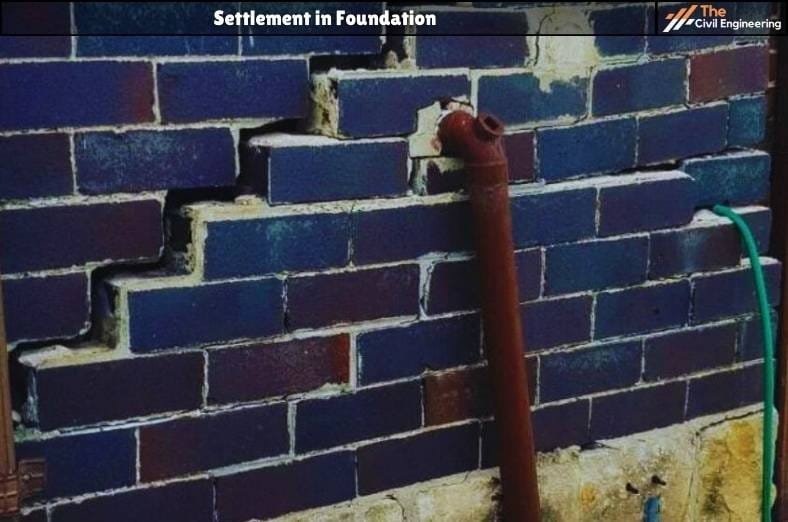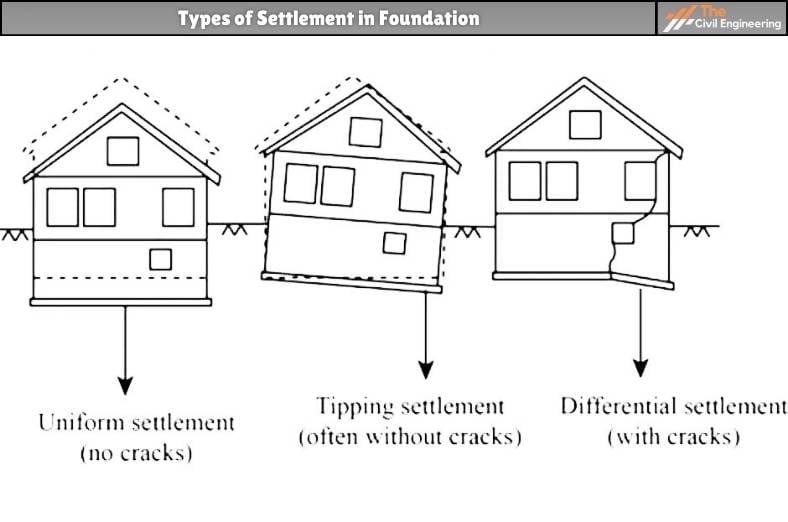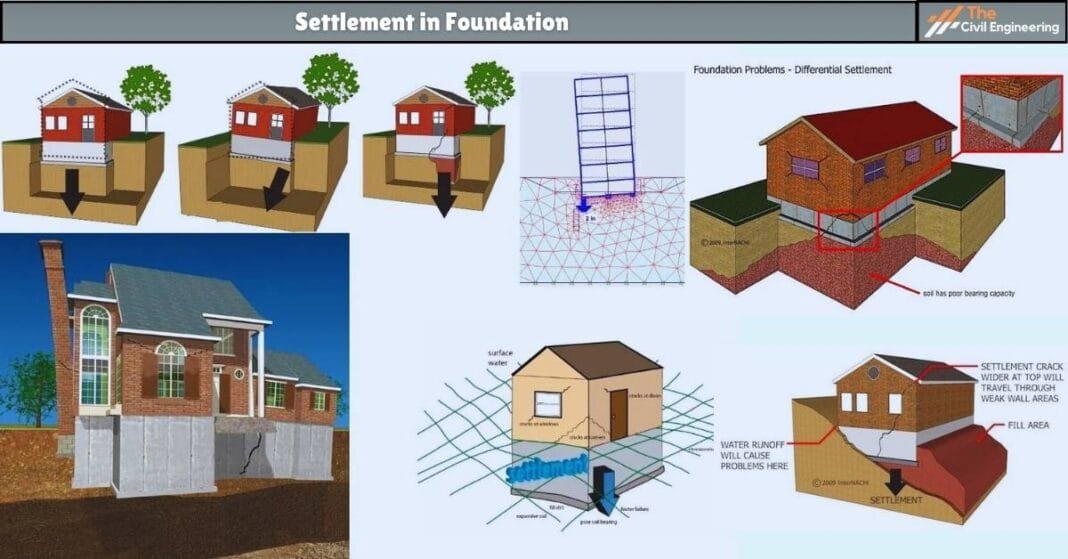Settlement in foundation may be understood as the distortion of the foundation i.e. the total vertical displacement at the foundation level.
The primary cause of the settlement is the reduction in the air-void ratio of soil.
In other words, settlement in foundation refers to the disruption of the foundation mainly due to the following:
a. Unequal compression in the foundations.
b. Application of the varied and undue load to the structure.
c. The occurrence of considerable shrinkage.
The deformation of soil under the application of a load of foundation structures is inevitable.
The magnitude of such settlement depends mainly on the type of soil and the structure of the foundation itself.
For example, the settlement of the foundation is relatively higher in the case of the foundations in the clay soil than that in the bedrock.
Read Also: Proposes of Building Foundation
2. Causes of Settlement in Foundation
The causes of settlement in the foundation can be divided into two types i.e. the direct causes and the indirect causes.
1. Direct Causes
These are the causes that directly act upon the foundation.
The direct cause of foundation settlement includes the weight of the structure built on top of it.
It includes both the dead load and the live load coming from the superstructure.
2. Indirect Causes
The indirect causes of settlement in the foundation can be listed as follows:
a. Poor Construction of Foundation:
The design of the foundation can also affect the settlement of the foundation significantly.
For example, the settlement is more in foundations that do not have the proper reinforcements to withstand the soil deformations than in a foundation with proper reinforcements.
b. Variations in Weather Conditions:
The various changes in the weather conditions can also be responsible for the settlement in the foundation.
Usually, the heavy rainfalls and storms can over-saturate the soil thereby making the soil soft and heavy.
On the other hand, the dry weather conditions particularly drought can lead to the formation of gaps in the compacted soil thus causing the settlement.
The alternate freezing and thawing action also causes the settlement in the foundation.
c. Consolidation of Soil:
The improper or poor compaction of the soil can also result in unequal settlement in the foundation.
d. Existing Soil Condition & Type of Soil:
The compression of the soil under the structural and foundation load is inevitable.
Such compression of soil forces the water out of the soil layers thereby making it denser which leads to deformation.
Usually, expansive soils like clay are dense and also react quickly to the water thereby undergoing more deformation.
On the other hand, sandy soils and loam soils have better drain properties which make them more stable.
e. Vegetation:
Another indirect cause of the foundation settlement is the presence of trees nearby the vicinity of the foundations.
This is because the roots of the plants and trees absorb the moisture from the soil, particularly during prolonged dry periods. It results in the shrinkage of the soil thus increasing the possibility of settlement in the foundation.
f. Vibrations:
Subsequent vibrations during earthquakes or traffic loads can cause the settlement in the foundation.
3. Effects of Settlement in Foundation
Some of the effects of the settlement in the foundation can be listed as follows:
1. Cracking of the concrete slabs and foundation walls.
2. Skewing of the wood framing thereby resulting in distortion of the doors and windows.
3. Breakage in the seams between the drywall panels.
4. Tilting of the various structural components such as chimneys, exterior stairs, etc.
5. Bulging of the walls.
6. Changes in the relative position of the foundation.
7. Distortion of the floors in extreme cases.

4. Types of Settlement in Foundation
The settlement in the foundation can be classified into two types namely the uniform foundation settlement and the differential foundation settlement.

a. Uniform Foundation Settlement
It is the settlement that occurs at the same rate. Usually, when all the parts of the superstructure rest on the same type of soil, a uniform settlement is most likely to occur.
Also, when the loads imposed on the superstructures, as well as the design of the structural system, are uniform in nature, uniform settlement occurs.
Such type of foundation settlement usually does not have much harmful effect on the structural system of the superstructure.
In extreme cases, the uniform foundation may adversely affect the utilities of the structure such as damaging the sewers and pipelines, jamming of the doors and windows, etc.
b. Differential Foundation Settlement
It is the settlement that occurs at varied rates in the different portions of the superstructure.
It commonly occurs when different types of soil are found underneath or varied structural systems exist between the parts of the superstructure.
The difference in the load imposed on the structure also causes the foundation to settle by substantially varied amounts.
The differential settlement may lead to the distortion of the structural components and even the overall structure collapse in extreme cases.
It may also result in the cracking of walls, sloping of the floors, distortion of the frames of windows and doors, etc.
Most of the foundation failures noted have occurred due to extreme differential foundation settlements.
The permissible (or acceptable) differential settlement for typical buildings with isolated foundations is 20mm and the permissible total settlement is 50mm.
The differential settlements exceeding the permissible values can significantly affect the structure.
The most common and renowned example of differential settlement in the world is the Leaning Tower of Pisa.
The construction of the Leaning Tower of Pisa took about two centuries to complete due to the problems associated with the differential settlement and inclination.
As the Leaning Tower of Pisa is constructed on the wetlands, the geological profile of the soil consists of clay and fine sand and is also characterized by a high level of groundwater.
The main cause of the differential settlement and inclination of the Leaning Tower of Pisa is the excessive deformability and compressibility of the foundation soil in the area underneath the southern part of the Tower.
c. Tilting
Tilting is a nonuniform settlement often without cracks. It mostly occurs due to the liquefaction of soil that leads to the tilting of the entire structure.
5. Preventive Measures of Settlement in Foundation
Some of the preventive measures that can be adopted for reducing the settlements in the foundation can be listed as follows:
a. Proper geotechnical exploration and investigation works must be carried out before commencing the construction.
b. Appropriate design of the foundation must be done.
c. The existing soil condition, soil type, and groundwater must be analyzed properly. The best type of soil for the construction of the foundation is non-expansive soil i.e. soils with a very little amount of silt and clay.
d. One of the techniques used for minimizing the settlements is to perform the excavation of an amount of soil that weighs the same as the building.
e. As far as possible, construction in the soil with excessive silt must be avoided.
f. Resting of the foundation on hard and rigid strata such as rock layers.
g. The base of the footing must be designed appropriately.
h. The pressure in the soil underneath must be limited.
i. Eccentric loading must be avoided as far as possible.
6. Warning Signs of Foundation Settlement
Some of the symptoms or the warning signs of the settlement in the foundation can be listed as follows:
1. Noticeable cracks in the foundations and the walls.
2. Difficulty in opening the doors and the windows.
3. Sloping or unevenness of the floors and cracking of tiles.
4. Presence of interior cracks in the building.
5. Presence of rotten woods in beams and piers.
6. Separation of the expansion joints.
This was for the Settlement in Foundation.
Read More: 9 Purposes of Building Foundation
Read More: 6 Types of Hip Roof


